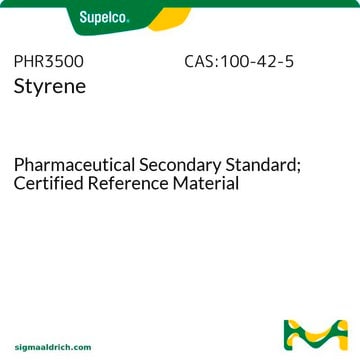W323306
Styrene
≥99%
Synonyme(s) :
Phenylethylene, Vinylbenzene
About This Item
Produits recommandés
Source biologique
synthetic
Conformité réglementaire
FDA 21 CFR 172.515
Densité de vapeur
3.6 (vs air)
Pression de vapeur
12.4 mmHg ( 37.7 °C)
4.3 mmHg ( 15 °C)
Essai
≥99%
Forme
liquid
Température d'inflammation spontanée
490 °F
914 °F
Peut contenir
<15 ppm 4-tert-butylcatachol, synthetic as stabilizer
Limite d'explosivité
6.1 %
Disponibilité
not available in USA
Indice de réfraction
n20/D 1.546 (lit.)
pb
145-146 °C (lit.)
Pf
−31 °C (lit.)
Densité
0.906 g/mL at 25 °C
Application(s)
flavors and fragrances
Documentation
see Safety & Documentation for available documents
Allergène alimentaire
no known allergens
Propriétés organoleptiques
medicinal; plastic
Température de stockage
2-8°C
Chaîne SMILES
C=Cc1ccccc1
InChI
1S/C8H8/c1-2-8-6-4-3-5-7-8/h2-7H,1H2
Clé InChI
PPBRXRYQALVLMV-UHFFFAOYSA-N
Vous recherchez des produits similaires ? Visite Guide de comparaison des produits
Produit(s) apparenté(s)
Mention d'avertissement
Danger
Mentions de danger
Conseils de prudence
Classification des risques
Acute Tox. 4 Inhalation - Aquatic Chronic 3 - Asp. Tox. 1 - Eye Irrit. 2 - Flam. Liq. 3 - Repr. 2 - Skin Irrit. 2 - STOT RE 1 Inhalation - STOT SE 3
Organes cibles
hearing organs, Respiratory system
Code de la classe de stockage
3 - Flammable liquids
Classe de danger pour l'eau (WGK)
WGK 2
Point d'éclair (°F)
89.6 °F - closed cup
Point d'éclair (°C)
32.0 °C - closed cup
Équipement de protection individuelle
Eyeshields, Faceshields, Gloves, type ABEK (EN14387) respirator filter
Faites votre choix parmi les versions les plus récentes :
Déjà en possession de ce produit ?
Retrouvez la documentation relative aux produits que vous avez récemment achetés dans la Bibliothèque de documents.
Les clients ont également consulté
Notre équipe de scientifiques dispose d'une expérience dans tous les secteurs de la recherche, notamment en sciences de la vie, science des matériaux, synthèse chimique, chromatographie, analyse et dans de nombreux autres domaines..
Contacter notre Service technique












